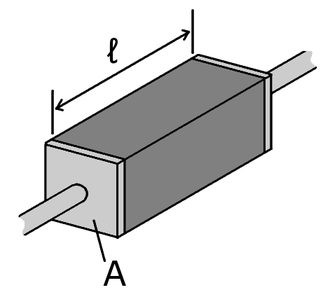Unit of Specific Resistance - Definition, Resistance Vs Electrical Resistance, FAQs
Resistance Definition:
In an electric circuit, resistance could be a measure of the opposition to current flow.

What is Specific Resistance?
Specific Resistance:- When a voltage is applied to a substance, its specific resistance to a current is defined as the resistance provided by a unit length and unit cross-section of the substance. The unit of specific resistance is Ω m. Specific resistance, often known as electrical resistivity, is a measurement of a particular element's conductivity.

The Specific resistance of a conducting substance can be stated mathematically as,
$\rho=\frac{R A}{L}$
Where,
R denotes the conductor's resistance.
L is the conductor's length.
A = conductor's cross-sectional area.
ρ = the material's proportionality constant, often known as its specific resistance or resistivity.
The Ohm-meters (Ω m) is the unit of specific resistance.
Also read -
- NCERT Solutions for Class 11 Physics
- NCERT Solutions for Class 12 Physics
- NCERT Solutions for All Subjects
Specific Resistance Vs Electrical Resistance
A material's specific resistance is an inherent property that is determined by its composition. However, the electrical resistance is an intrinsic property that is determined by the conductor's length and cross-section, as well as the applied potential difference. Ohm (. m) is the SI unit for specific resistance is ohm-meters (Ω m), whereas Ohm is the SI unit for electrical resistance.
Specific Resistance Definition
When a voltage is applied to a substance, its specific resistance to a current is defined as the resistance provided by a unit length and unit cross-section of the substance.
The formula of specific resistance
The Specific resistance of a conducting substance can be stated mathematically as,
$\rho=\frac{R A}{L}$
Where,
R denotes the conductor's resistance.
l is the conductor's length.
a = conductor's cross-sectional area.
ρ = the material's proportionality constant, often known as its specific resistance or resistivity.
The Ohm-meters (Ω m) is the unit of specific resistance.
|
Related Topics Link, |
SI unit of specific resistance / Unit of Specific resistance
The Ohm-meters (Ω m) is the unit of specific resistance.
Ohm-meter symbol: Ω m
Factors affecting the specific resistance
Specific resistance is dependent upon the temperature, composition, and pressure of the material. Temperature affects specific resistance. The specific resistance of various materials increases as the temperature rises. The resistance of such elements is considered as having a positive coefficient of temperature. It will increase for such elements as the temperature rises. Similarly, as the temperature rises, the resistance of particular elements decreases. The coefficient of such elements is considered to be negative. The resistance of such elements decreases as the temperature rises.
Specific Resistance of some materials:
- The specific resistances of copper at 200C
- Value: 1.68*10-8
- Type: conductor
- Unit of specific resistance: ohm-meters
- The specific resistances of silver at 200C
- Value: 1.59*10-8
- Type: conductor
- Unit of specific resistance: ohm-meters
- The specific resistances of iron at 200C
- Value: 9.70*10-8
- Type: conductor
- Unit of specific resistance: ohm-meters
Also Read:
- NCERT solutions for Class 12 Physics Chapter 3 Current Electricity
- NCERT Exemplar Class 12 Physics Solutions Chapter 3 Current Electricity
- NCERT notes Class 12 Physics Chapter 3 Current Electricity
- The specific resistances of platinum at 200C
- Value: 1.06*10-8
- Type: conductor
- Unit of specific resistance: ohm-meters
- The specific resistances of gold at 200C
- Value: 2.44*10-8
- Type: conductor
- Unit of specific resistance: ohm-meters
- The specific resistances of Tin at 200C
- Value: 1.09*10-8
- Type: conductor
- Unit of specific resistance: ohm-meters
- The specific resistances of Glass at 200C
- Value: 1011-1015
- Type: insulators
- Unit of specific resistance: ohm-meters
- The specific resistances of Rubber at 200C
- Value: 1013
- Type: insulators
- Unit of specific resistance: ohm-meters
- The specific resistances of a Diamond at 200C
- Value: 1012
- Type: insulator
- Unit of specific resistance: ohm-meters
- The specific resistances of air at 200C
- Value: 109-1015
- Type: insulator
- Unit of specific resistance: ohm-meters
Also check-
- NCERT Exemplar Class 11th Physics Solutions
- NCERT Exemplar Class 12th Physics Solutions
- NCERT Exemplar Solutions for All Subjects
NCERT Physics Notes:
Frequently Asked Questions (FAQs)
Conductance is the reciprocal of resistance.
A material's specific resistance is an inherent property that is determined by its composition. However, resistance is an intrinsic property that is determined by the conductor's length and cross-section, as well as the applied potential difference. Ohm (. m) is the SI unit for specific resistance is ohm-meters (Ω m), whereas Ohm is the SI unit for resistance.
Copper has a very low specific resistance, with a value of 1.68* 10-8 Ω m at 20°C. Copper is a good conductor of electricity due to its low resistivity. As a result of its low specific resistance, copper is preferred in most electrical wiring.
The resistivity of glass is approximately 1014. Glass is usually formed when molten material cools too quickly to form a regular crystal lattice. Most of the common glasses are made of the same chemical composition as quartz.